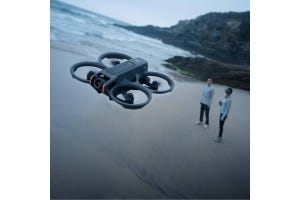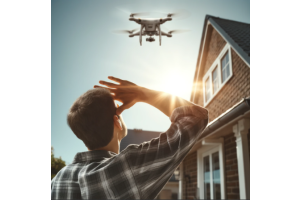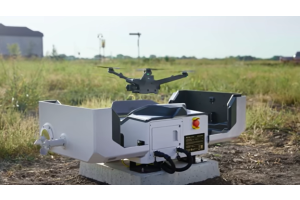The Matrice 200 platform was first introduced on February 26th, 2017. Now on February 21st, 2019 DJI has given a mid-cycle update to the popular Matrice 200 series. The 200 series was the first serious push into the commercial grade drone market for enterprise and industrial use. With powerful features such as ADS-B sensing of manned aircraft, dual high capacity batteries for redundancy, dual and top-mounted camera gimbal mounts, IP43 water resistance, and powerful motors for up to 51 Mph of flight speed the first generation of the Matrice 200 series was a true industrial drone game changer. The DJI Matrice 200 series became the goto drone platform for surveying, inspections, firefighting, and SAR operations. The second version of the Matrice 200 series builds on the already impressive matrice 200 series. Find out what is new below!

Transmission: The new Matrice 200 series uses the newest image transmission technology from DJI known as Ocusync 2.0. This system will give up to 1080P live video in 5 miles of range. In addition to increased transmission resolution at farther distance new secure data transmission system ensures that critical information stays safe with AES-256 data encryption.
Data Accuracy: Position data aligns the drones flight controller, GPS module, and any other DJI payloads for precise geotagging.
Discreet Mode: All lights on the UAV can be completely turned off in the DJI Pilot app. This allows for stealth mode for when situations call for unobtrusive drone operations.
What is the flight time of the Matrice 200 Series V2 drones?
The new Matrice 200 series V2 supports only the high capacities TB55 batteries and no longer the standard capacity TB50 batteries. With a full payload the M200 V2, M210 V2, and M210 RTK have a flight time of 24 minutes.
What gimbal cameras are compatible with the M200 Series V2 drones?
The Zenmuse X4s, X5S, X7, XT, XT2, and Z30 are compatible with the M200 series V2.
How are the M200 Series and M200 Series V2 drones different visually?
The M200 Series V2 drones have new beacons on the top and bottom of the drone. Also, the V2 arm lights are slightly different with optical lenses. Lastly, there is an engraving on the body of the drone marking it as the V2. The RTK system has also been updated with DJI’s D-RTK 2 high precision GNSS antennas.
What is the waterproof rating on the DJI Matrice 200 Series V2?
The version 2 has the same ingress protection as the original with a rating of IP43. This means that the Matrice 200 Series V2 can be protected from objects greater than 1 millimeter, and from water spray less than 60 degrees vertically. The IP43 protection rating can protect the Matrice 200 Series V2 when used in adverse environments with dust particles or light showers.
DJI Matrice 200 V2 Specs
| Dimensions | Unfolded, propellers and landing gears included, 883×886×398 mm<br> Folded, propellers and landing gears excluded, 722×247×242 mm” |
| Diagonal Wheelbase | 643 mm |
| Weight | Approx. 4.69 kg (with two TB55 batteries) |
| Max Takeoff Weight | 6.14 kg |
| Max Payload | 1.45 kg |
| Operating Frequency | 2.4000-2.4835 GHz; 5.725-5.850 GHz |
| EIRP | 2.4 GHz: ≤ 26 dBm (NCC/FCC); ≤ 20 dBm (CE/MIC); ≤ 20 dBm (SRRC)<br> 5.8 GHz: ≤ 26 dBm (NCC/FCC); ≤ 14 dBm (CE); ≤ 26 dBm (SRRC)” |
| Hovering Accuracy (P-mode with GPS) | Vertical:±1.64 feet (±0.5 m) or ±0.33 feet(±0.1 m, Downward Vision System enabled)<br> Horizontal:±4.92 feet (±1.5 m) or ±0.98 feet (±0.3 m, Downward Vision System enabled)” |
| Max Angular Velocity | Pitch: 300°/s, Yaw: 120°/s |
| Max Pitch Angle | S-mode: 35°;<br> P-mode: 30° (Forward Vision System enabled: 25°); A-mode: 30° |
| Max Ascent Speed | 16.4 ft/s (5 m/s) |
| Max Descent Speed (vertical) | 9.8 ft/s (3 m/s) |
| Max Speed | S-mode/A-mode 81 kph (50.3 mph); P-mode: 61.2 kph (38 mph) |
| Max Service Ceiling Above Sea Level | 9842 feet (3000 m, with 1760S propellers) |
| Max Wind Resistance | 39.4 ft/s (12 m/s) |
| Max Flight Time (with two TB55 batteries) | 38 min (no payload), 24 min (takeoff weight: 6.14 kg) |
| Supported DJI Gimbals | Zenmuse X4S/X5S/X7/XT/XT2/Z30 |
| Supported Gimbal Mounting | Single Gimbal, Downward |
| Ingress Protection Rating | IP43 |
| GNSS | GPS+GLONASS |
| Operating Temperature | -4° to 122° F (-20° to 50° C) |
| Operating Frequency | 2.4000-2.4835 GHz; 5.725-5.850 GHz |
| Max Transmitting Distance (unobstructed, free of interference)” | NCC/FCC: 5 mi (8 km); <br>CE/MIC: 3.1 mi (5 km); <br>SRRC: 3.1 mi (5 km) |
| EIRP | 2.4 GHz: ≤ 26 dBm (NCC/FCC); ≤ 20 dBm (CE/MIC); ≤ 20 dBm (SRRC) 5.8 GHz: ≤ 26 dBm (NCC/FCC); ≤ 14 dBm (CE); ≤ 26 dBm (SRRC)” |
| Power Supply | Extended Intelligent Battery (Model: WB37-4920mAh-7.6V) |
| Output Power (max) | 13 W (Without supplying power to monitor) |
| USB Power Supply | 1 A⎓ 5.2 V (max) |
| Operating Temperature | -4° to 122° F (-20° to 50° C) |
| Velocity Range | <32.8 ft/s (10 m/s) at the height of 6.56 feet (2 m) |
| Altitude Range | <32.8 feet (10 m) |
| Operating Range | <32.8 feet (10 m) |
| Operating Environment | Surfaces with clear patterns and adequate lighting (> 15 lux) |
| Ultrasonic Sensor Operating Range | 0.33-16.4 feet (0.1-5 m) |
| Ultrasonic Sensor Operating Environment | Non-absorbing material, rigid surface (thick indoor carpeting will reduce performance) |
| Obstacle Sensing Range | 2.3-98.4 feet (0.7-30 m) |
| FOV | Horizontal 60°; Vertical: 54° |
| Operating Environment | Surfaces with clear patterns and adequate lighting (> 15 lux) |
| Obstacle Sensing Range | 0-16.4 feet (0-5 m) |
| FOV | ±5° |
| Operating Environment | Large, diffuse and reflective obstacles (reflectivity >10%) |
| Capacity | 7660 mAh |
| Voltage | 22.8 V |
| Battery Type | LiPo 6S |
| Energy | 174.6 Wh |
| Net Weight (Single One) | Approx. 885 g |
| Operating Temperature | -4° to 122° F (-20° to 50° C) |
| Charging Temperature | 41° to 104° F (5° to 40° C) |
| Max Charging Power | 180 W |
| Voltage | 26.1 V |
| Rated Power | 180 W |
| Input Voltage | 26.1 V |
| Input Current | 6.9 A |
DJI Matrice 210 & RTK V2 Specs
| Dimensions | M210 V2: Unfolded, propellers and landing gears included, 883×886×398 mm. Folded, propellers and landing gears excluded, 722×282×242 mm
M210 RTK V2: Unfolded, propellers and landing gears included, 883×886×427 mm. Folded, propellers and landing gears excluded, 722×282×242 mm |
| Diagonal Wheelbase | 643 mm |
| Weight | M210 V2: Approx. 4.8 kg (with two TB55 batteries); M210 RTK V2: Approx. 4.91 kg (with two TB55 batteries) |
| Max Takeoff Weight | 6.14 kg |
| Max Payload | M210 V2: 1.34 kg; M210 RTK V2: 1.23 kg |
| Operating Frequency | 2.4000-2.4835 GHz; 5.725-5.850 GHz |
| EIRP | 2.4 GHz: ≤ 26 dBm (NCC/FCC); ≤ 20 dBm (CE/MIC); ≤ 20 dBm (SRRC)<br> 5.8 GHz: ≤ 26 dBm (NCC/FCC); ≤ 14 dBm (CE); ≤ 26 dBm (SRRC) |
| Hovering Accuracy (P-mode with GPS) | Vertical: ±1.64 feet (±0.5 m) or ±0.33 feet (±0.1 m, Downward Vision System enabled)<br> Horizontal: ±4.92 feet (±1.5 m) or ±0.98 feet (±0.3 m, Downward Vision System enabled) |
| Hovering Accuracy (D-RTK, M210 RTK V2) | Vertical: ±0.33 feet (±0.1 m); Horizontal: ±0.33 feet (±0.1 m) |
| Max Angular Velocity | Pitch: 300°/s, Yaw: 120°/s |
| Max Pitch Angle (Dual Downward Gimbal/Single Upward Gimbal) | S-mode: 30°; P-mode: 30° (Forward Vision System enabled: 25°); A-mode: 30° |
| Max Pitch Angle [Single Downward Gimbal(Gimbal Connector I)] | S-mode: 35°; P-mode: 30° (Forward Vision System enabled: 25°); A-mode: 30° |
| Max Ascent Speed | 16.4 ft/s (5 m/s) |
| Max Descent Speed (vertical) | 9.8 ft/s (3 m/s) |
| Max Speed (Dual Downward Gimbal/Single Upward Gimbal) | S-mode/A-mode: 73.8 kph (45.9 mph); P-mode: 61.2 kph (38 mph) |
| Max Speed [Single Downward Gimbal(Gimbal Connector I)] | S-mode/A-mode: 81 kph (50.3 mph); P-mode: 61.2 kph (38 mph) |
| Max Service Ceiling Above Sea Level | 9842 feet (3000 m, with 1760S propellers) |
| Max Wind Resistance | 39.4 ft/s (12 m/s) |
| Max Flight Time (with two TB55 batteries) | M210 V2: 34 min (no payload), 24 min (takeoff weight: 6.14 kg)<br> M210 RTK V2: 33 min (no payload), 24 min (takeoff weight: 6.14 kg) |
| Supported DJI Gimbals | Zenmuse X4S/X5S/X7/XT/XT2/Z30 |
| Supported Gimbal Configurations | Single Downward Gimbal, Dual Downward Gimbals, Single Upward Gimbal |
| Ingress Protection Rating | IP43 |
| GNSS | M210 V2: GPS+GLONASS; <br> M210 RTK V2: GPS+GLONASS+BeiDou+Galileo |
| Operating Temperature | -4° to 122° F (-20° to 50° C) |
| Operating Frequency | 2.4000-2.4835 GHz; 5.725-5.850 GHz |
| Max Transmitting Distance(unobstructed, free of interference) | NCC/FCC: 5 mi (8 km); CE/MIC: 3.1 mi (5 km); SRRC: 3.1 mi (5 km) |
| EIRP | 2.4 GHz: ≤ 26 dBm (NCC/FCC); ≤ 20 dBm (CE/MIC); ≤ 20 dBm (SRRC)<br> 5.8 GHz: ≤ 26 dBm (NCC/FCC); ≤ 14 dBm (CE); ≤ 26 dBm (SRRC) |
| Power Supply | Extended Intelligent Battery (Model: WB37-4920mAh-7.6V) |
| Output Power (max) | 13 W (Without supplying power to monitor) |
| USB Power Supply | 1 A⎓5.2 V (max) |
| CrystalSky Monitor | DJI CrystalSky 7.85inch, Resolution: 2048×1536; Brightness: 2000 cd/m2; Operating System: Android 5.1; Storage: ROM 128GB |
| Operating Temperature | -4° to 122° F (-20° to 50° C) |
| Velocity Range | <32.8 ft/s (10 m/s) at the height of 6.56 feet (2 m) |
| Altitude Range | <32.8 feet (10 m) |
| Operating Range | <32.8 feet (10 m) |
| Operating Environment | Surfaces with clear patterns and adequate lighting (>15 lux) |
| Ultrasonic Sensor Operating Range | 0.33-16.4 feet (0.1-5 m) |
| Ultrasonic Sensor Operating Environment | Non-absorbing material, rigid surfaces (thick indoor carpeting will adversely affect performance) |
| Obstacle Sensing Range | 2.3-98.4 feet (0.7-30 m) |
| FOV | Horizontal: 60°; Vertical: 54° |
| Operating Environment | Surfaces with clear patterns and adequate lighting (> 15 lux) |
| Obstacle Sensing Range | 0-16.4 feet (0-5 m) |
| FOV | ±5° |
| Operating Environment | Large, diffuse, and reflective obstacles (reflectivity >10%) |
| Capacity | 7660 mAh |
| Voltage | 22.8 V |
| Battery Type | LiPo 6S |
| Energy | 174.6 Wh |
| Net Weight (Single One) | Approx. 885 g |
| Operating Temperature | -4° to 122° F (-20° to 50° C) |
| Charging Temperature | 41° to 104° F (5° to 40° C) |
| Max Charging Power | 180 W |
| Voltage | 26.1 V |
| Rated Power | 180 W |
| Input Voltage | 26.1 V |
| Input Current | 6.9 A |









